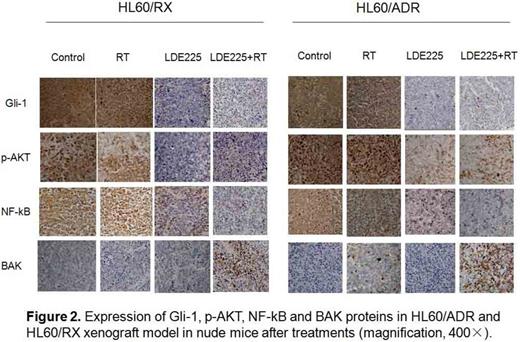Abstract
PURPOSE: Total body irradiation (TBI) combined with chemotherapy is currently the most effective procedure of traditional preparative myeloablative regimen. However, resistance to chemotherapy in refractory acute myeloid leukemia (AML) is associated with short-time recurrence after Allo-HSCT. To investigate the mechanism of Hedgehog signaling pathway resulting in resistance, we used primary AML cells originated in refractory patients and 3 cell lines including HL60, HL60/ADR (a adriamycin-resistant cells), and HL60/RX (a radiation-resistant cell line established from HL60) as cellular modes to examine the expression of p-IGF-1R, IRS-1, p-Akt, Gli-1, MRP1, Bcl-2, and explored the safety and efficacy of NVP-LDE225 (an inhibitor of Hedgehog pathway) for enhancing the sensitivity to treatment in refractory leukemia in vitro and in vivo.
Methods: The expression of Hedgehog signaling pathway was measured in 3 leukemia cell lines, and primary leukemia cells originated in refractory AML patients and non-refractory AML patients using western blot technique. In in vitro experiments, HL60/ADR cells and HL60/RX cells were treated with DMSO (control) or NVP-LDE225 for 48 h, and then assigned in six groups respectively: (a) Control, (b) ADM alone, (c) Radiation alone (d) NVP-LDE225 alone, (e) NVP-LDE225+ADM, (f) NVP-LDE225+Radiation. Flow cytometry, MTT assay and Western-Blot were performed separately to detect apoptosis, adriamycin uptake rate, proliferation inhibit rate and the expression of MRP1, p-IGF-1R, IRS-1, p-Akt, Gli-1, and Bcl-2. Furthermore, based on the results in vitro, the serial tumor volumes, general condition of the mice, complete blood counts, multiple organs injury, and the expression levels of hedgehog signaling pathway were used to detect the antitumor efficacy and toxicity of NVP-LDE225 in HL60/ADR and HL/RX xenograft model.
Results: Our result showed that, compared with leukemia cells in non-refractory AML patients and HL60 cells, the expression of hedgehog signaling pathway protein was significantly elevated in refractory AML, HL60/ADR and HL60/RX cells(P<0.01). In addition, we also observed that NVP-LDE225 (10µM) could reverse ADM, DNR, HHT, and Ara-c resistance in HL60/ADR cells. Combining ADM with NVP-LDE225 (20µM) could markedly increase apoptosis and ADM positive rate of intracellular fluorescence detection than other groups (P<0.05). Moreover, combination of NVP-LDE225 with radiation could significantly increase radiation-induced apoptosis and exhibit higher expression of phosphorylation of histone H2AX and BAK than any other single treatment groups both in HL60/RX and HL60/ADR cells(P<0.05). In vivo, both in HL60/RX and HL60/ADR mice model, combination of NVP-LDE225 simultaneously and post 2 days or 5 days with ADM or radiation all presented significantly antitumor effect and high survival rate compared with the control or single agent mice (P<0.01), but there were no significant differences between the three combined treatment groups. Within the combination- and ADM-treated groups, nadir of the white blood cell and platelet counts were reached in day 8 with a gradual recovery starting at day 11. Finally, decrease in IRS-1, Gli-1, p-AKT, and NF-kb expressions were observed after treating with NVP-LDE225 in vitro and in tumor tissue. None of the pathological lesion in the heart, liver, kidney, brain, and lung was observed among all groups.
Conclusion: The findings from this study demonstrated that Gli-1/p-Akt/NF-kb pathway play a key role for resistance to both drug and irradiation, and suggested that the combination of hedgehog pathway inhibitor (NVP-LDE225) with chemotherapy or radiotherapy could significantly enhance the antitumor activity via overcoming chemoresistance or radioresistance. The myelosuppression and toxicity could be well tolerated
No relevant conflicts of interest to declare.
Author notes
Asterisk with author names denotes non-ASH members.



